
California 26 Feb - 28 March | 28 March - 18 April |
France 18 April - 16 May |
Italy 16 May to 23 May
France 2 23 May - 6 June |
England & Germany 6 June - 27 June |
Cambodia 4 July - 28 July
Home |
Where in the world? |
Little Henry |
Big Al
G'day |
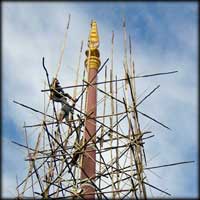 The entrance to the Wat is coming along nicely.
The entrance to the Wat is coming along nicely.The golden bird - a Garuda - has been placed on top of the tall concrete column and the work of dismantling the scaffolding has begun. The same has happened to the corresponding column. Each length of bamboo taken off has to be lowered to the ground by rope. Notice that there are no platforms for the workers to stand on, or ladders to go up and down. They have to rely on their climbing (and self-preservation) skills at all times. |
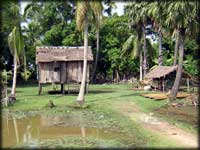 We took a trip out of the city of Phnom
Penh and headed to the north of the country, to Siem Reap. We travelled by bus through the provinces of
Kandal, Kompong Cham and Kompong Thom, through long stretches of rural land with the occasional village
or small town along the way. We took a trip out of the city of Phnom
Penh and headed to the north of the country, to Siem Reap. We travelled by bus through the provinces of
Kandal, Kompong Cham and Kompong Thom, through long stretches of rural land with the occasional village
or small town along the way. The way the countryside is settled is fairly similar along this route. The houses of the farmers tend to hug the road in typical ribbon development, while behind them stretch the rice fields. Since the landscape is almost uniformly flat, there is almost little else to see except the palm trees punctuating the horizon. Most of the houses have a small pond in front which may contain fish and is often the source of water for washing themselves and their clothes. The proximity to the main road allows for easy transportation. This hut would be one of the smaller ones, belonging to a relatively poor family. |
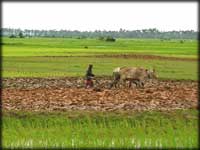 Nearly all agricultural activities are still
carried out by manual labour. Nearly all agricultural activities are still
carried out by manual labour. The majority of rice fields in the country are still prepared by ploughing with oxen. They are tethered two to a plough, which is a single furrow blade. Ploughing usually takes place after the rainy season has begun so that the soil is soft. Very little other preparation takes place, except harrowing which tends to level the soil and attempts to iron out any low or high spots in the field. This is usually done when the field is very wet. Planting is also done with water laying in the field or even when it is inundated. |
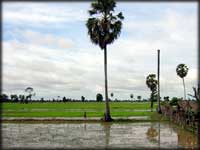 The flatness of the countryside. The flatness of the countryside.The vastness of the sky. |
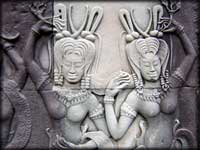 The heavenly Apsaras. The heavenly Apsaras.Located just north of Siem Reap is one of the greatest historical treasures in the world. The complex of Angkor. And, perhaps one of the best known features of Angkor, and which adorn the walls in their hundreds, are the Apsaras, the heavenly nymphs. These girls are around 900 years old, are located on the outer walls of a building in Angkor Wat that is exposed to the elements, and still the skill with which they were fashioned is plainly evident. The technique for the construction and embellishment of the temple complex is also clear here. The stones were first cut to size and put in place creating a blank canvas that was then completed by artisans is situ. The number of tradesman and artisans required and their skill level makes for some staggering contemplation. |
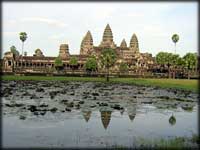 The main temple at Angkor is Angkor
Wat itself. The whole structure and grounds occupy 210 hectares, surrounded by a moat 200 metres wide.
The perimeter of the enclosing wall is 5.5 kilometres. The centre tower is 65 metres high. The main temple at Angkor is Angkor
Wat itself. The whole structure and grounds occupy 210 hectares, surrounded by a moat 200 metres wide.
The perimeter of the enclosing wall is 5.5 kilometres. The centre tower is 65 metres high. It is estimated that when it was built in the twelfth century, it would have taken thirty years to complete. One of the most amazing things about this temple is its high degree or preservation. This is a mixture of great building skills, deference to the structure shown by the Khmer over centuries and the fortuitous 'loss' of Angkor to the jungle for several centuries after it was abandoned in the fifteenth century with the capital moving south to eventually settle in Phnom Penh. |
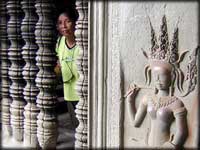 Another tourist at Angkor Wat! Another tourist at Angkor Wat!Showing the apsaras reliefs and the 'windows' of the day made from stone. The stone columns, known as balusters, must have been worked on lathes as they are so smooth. They were then later further embellished and stood up to make reliefs in otherwise solid walls. |
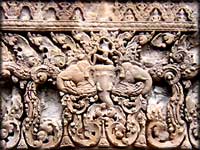 The lintel stone at the entrance to
Banteay Srei, a temple that is small but known for the delicacy and intricacy of its stone carvings. The lintel stone at the entrance to
Banteay Srei, a temple that is small but known for the delicacy and intricacy of its stone carvings.
Go to top of page |
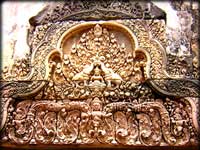 Another lintel at Banteay Srei, which
also illustrates the use of different blocks of stone and the order of construction being the setting of
the stones first and the carvings afterwards. Another lintel at Banteay Srei, which
also illustrates the use of different blocks of stone and the order of construction being the setting of
the stones first and the carvings afterwards. |
 Another tourist at the Banteay Samre temple.
Another tourist at the Banteay Samre temple. The archways and corridors are necessarily narrow as the roof over them is also made from block stone and it is difficult to vault stone over a wide area. Banteay Samre is a Hindu temple, as are most of the temples in the Angkor complex, dedicated to Vishnu. |
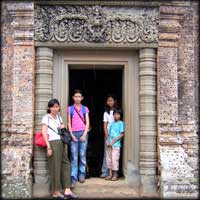 Our visit to East Mebon temple coincided with a downpour of rain, so we took shelter in the doorway of
one of the small towers at the top level. Except for the lintel and the doorway, these towers are
made of bricks.
Our visit to East Mebon temple coincided with a downpour of rain, so we took shelter in the doorway of
one of the small towers at the top level. Except for the lintel and the doorway, these towers are
made of bricks.East Mebon temple was built in the tenth century - over 1,000 years ago. It is a Hindu monument, ddevoted to Shiva. |
 The entrance way to Angkor Thom is
topped by a gopura, with four faces. The entrance way to Angkor Thom is
topped by a gopura, with four faces.Enter those who dare! |
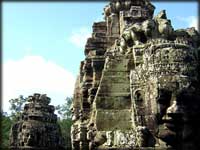 The Bayon. The most famous after Angkor Wat. The Bayon. The most famous after Angkor Wat.This one is a Buddhist temple built 100 years after Angkor Wat. There are over 200 large faces carved on its 54 towers. Whose face? Some historians think it is the Bodhisattva Avalokiteshvara. Others consider it to be the face of King Jayarvarman VII. This temple also contains walls of bas reliefs that surround the lower level. |
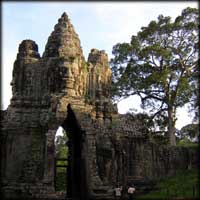 One of the exits from Angkor Thom, showing the passage under the gopura.
One of the exits from Angkor Thom, showing the passage under the gopura.
Go to top of page |
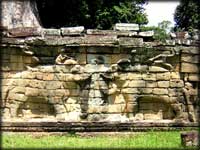 The Terrace of the Elephants extends over
300 metres, with the elephants depicted at close to life-size. All the elephants have riders. The Terrace of the Elephants extends over
300 metres, with the elephants depicted at close to life-size. All the elephants have riders. |
 The road through the Angkor complex is a local one that joins Siem Reap to villages further north. Thus,
there is a lot of local traffic. These people may go past these fantastic stone monuments every day, but
scarcely give them a glance.
The road through the Angkor complex is a local one that joins Siem Reap to villages further north. Thus,
there is a lot of local traffic. These people may go past these fantastic stone monuments every day, but
scarcely give them a glance.Yes, this is a motorcycle ramau. Fixed behind the rider to a pin , the trailer holds up to about fifteen people. While not the most stable machine stationary, there is no problem once it is mobile. The area is largely flat, so that helps, but the loads are still greater than the engine was ever designed for, so they work hard - and you can hear it. |
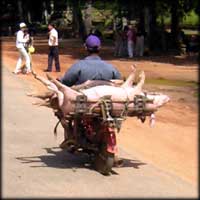 Motorcycles are used to transport just about everything. Here we have two heavy porkers on their last ride.
Motorcycles are used to transport just about everything. Here we have two heavy porkers on their last ride.I wouldn't necessarily say that they are enjoying it. Even though they will take in Angkor Thom, the Bayon and Angkor Wat (albeit upside-down) along the way. Go to top of page |
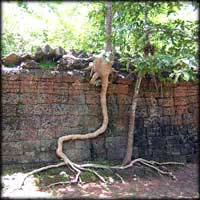 One of the effects of the jungle is the vegetation that grows directly on the stones of the temples. Many
of these have grown unchecked.
One of the effects of the jungle is the vegetation that grows directly on the stones of the temples. Many
of these have grown unchecked.This is the ficus tree, which has started its growth on the top of a wall of stone and the main root has wended its way down to the soil. As the roots grow and thicken, the stones become displaced, so that attempting to remove the tree may well bring down the structure with it. |
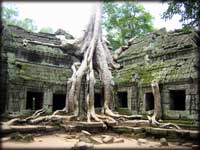 This brings us to Ta Phrom temple. This brings us to Ta Phrom temple.And I have to say that a quotation from M MacDonald sums it up best. "So the temple is held in a stranglehold of trees. Stone and wood clasp each other in grim hostility; yet all is silent and still, without any visible movement to indicate their struggle - as if they were wrestlers suddenly petrified, struck motionlesss in the middle of a fight. The rounds in this battle are not measured by minutes, but by centuries." |
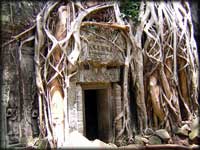 A battle for the doorway to the inner
part of the temple at Ta Phrom. A battle for the doorway to the inner
part of the temple at Ta Phrom. |
 The long sinuous arm of a tree root
spreads across the roof of an inner corridor at Ta Phrom. The long sinuous arm of a tree root
spreads across the roof of an inner corridor at Ta Phrom.Go to top of page |
 The legacy of hundreds of years
on the best efforts of man. The legacy of hundreds of years
on the best efforts of man.Stone inscriptions at Ta Phrom indicate that it serviced over 3,000 villages. It took 79,000 people to maintain the temple including 18 high priests, 2,700 officials and 615 dancers. Included as property of the temple was more than 500 kg of gold dishes, 35 diamonds, 40,600 pearls, 4,500 precious stones, 870 veils from China, 512 silk beds and 523 parasols. It must have something in its day. Yet, it is only one significant temple among dozens. |
|
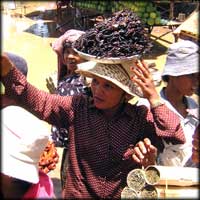 Leaving the
north again to head back to Phnom Penh, we pass through the small settlement of Skuon, famous for the
number of roadside sellers that surround your vehicle as you stop as for the goods they are selling -
mostly spiders. Leaving the
north again to head back to Phnom Penh, we pass through the small settlement of Skuon, famous for the
number of roadside sellers that surround your vehicle as you stop as for the goods they are selling -
mostly spiders. Deep fried black spiders. Very crunchy, apparently. |
 What sort of little goodies do we have here? No
spiders I see. What sort of little goodies do we have here? No
spiders I see. Just some sausage and bottles and bottles of preserved fruits, nuts and vegetables. And some dried fish. |
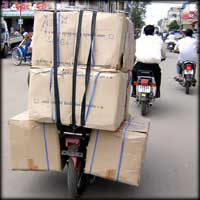 Back to the big smoke, where motocycles carry cardboard boxes of consumer goods and not pigs.
Back to the big smoke, where motocycles carry cardboard boxes of consumer goods and not pigs.Yes, there is a motorcycle under there somewhere, and the rider is well and truly crunched up against the handlebars with his arms forced out like a chicken flapping its wings, forced there by the cargo. The trick is just to keep moving, preferably not slowing down at all. Oh yes, and a crash helmet is recommended. |
 "Particularly nasty weather." "Particularly nasty weather."Anyone need a feather duster, long or short? A small basket perhaps? Kid's toys? Go to top of page |
More transport photos. To see an enlargement of an image, click on it.
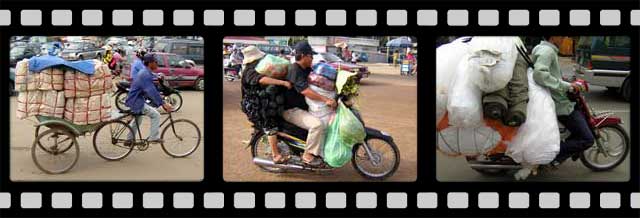 |
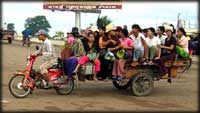 The local bus.
The local bus.Usually used for transportation over about ten to twenty kilometres, the moto-ramau is most commonly seen around Phnom Penh and other smaller town doing the circuit to outlying districts. You just have to take any vacant seat that is available when the ramau happens along. The capacity of a single ramau is hard to determine, this one has sixteen passengers, not including the driver. I have seen eighteen and no doubt there have been larger numbers carried. I don't think that Honda had the moto-ramau in mind when they designed their motorcycle engine. |
 A local peddlar. These feather dusters are made in local villages using chicken feathers tied to small
bamboo rods. They are sold door to door. The seller lives outside the city and has to ride his bicycle
to town, then he walks around streets at random until someone, who wants a feather duster, notices him
and calls him over. In quieter streets, he may even call out his goods to arouse people inside houses.
A local peddlar. These feather dusters are made in local villages using chicken feathers tied to small
bamboo rods. They are sold door to door. The seller lives outside the city and has to ride his bicycle
to town, then he walks around streets at random until someone, who wants a feather duster, notices him
and calls him over. In quieter streets, he may even call out his goods to arouse people inside houses.
Go to top of page |
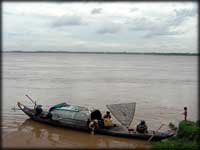 A fishing family. A fishing family.This is the mighty Mekong River. Never let it be said that it is an insignificant river. The family is having their midday rest from the river. The current is very strong and they must needs pull into the bank to tie up. The triangular net on the front deck is a trawling net, which they put down into the water and move the boat forward with the engine. Any fish that stray into the net can then be scooped up. The water is always muddy, so it is not possible to see anything under the water. |
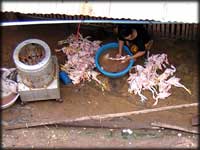 One thing you have to trust in your average
Cambodian street restaurant is that they cook everything thoroughly. This is a contract worker who
supplies chickens to restaurants. This is the plucking phase with the round drum with rubber protrusions
doing most of the work. However, the concrete slab they are resting on is outside, near a drain, and
while it would have been rinsed, would not have been scrubbed. The water for rinsing is straight out of
the river, by its colour. One thing you have to trust in your average
Cambodian street restaurant is that they cook everything thoroughly. This is a contract worker who
supplies chickens to restaurants. This is the plucking phase with the round drum with rubber protrusions
doing most of the work. However, the concrete slab they are resting on is outside, near a drain, and
while it would have been rinsed, would not have been scrubbed. The water for rinsing is straight out of
the river, by its colour.Economy 10. Hygeine 0. |
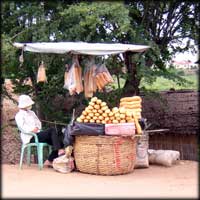 Bread sellers line the roads out of the cities and towns. Travellers by motorbike, car, taxi, bus,
moto-ramau and even on foot need sustenance and picking up your food along the road is a tradition.
Bread sellers line the roads out of the cities and towns. Travellers by motorbike, car, taxi, bus,
moto-ramau and even on foot need sustenance and picking up your food along the road is a tradition.Here the main problem is dirt, as the road is dusty and the bread is not covered, so it makes for some gritty chewing at times. Go to top of page |
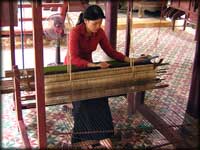 Cambodia is famous for its silk. Cambodia is famous for its silk.What is probably less well known is the labour involved in putting it together. After the thread is collected and spun, it is then hand-dyed for weaving. Then a woman sits at a loom and weaves the material in a 90 cm wide strip. It takes about a week to produce enough silk to make one skirt. |
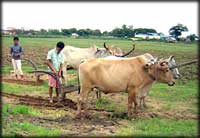 A farmer pulls up after a morning ploughing a
field ready for rice transplanting. The cattle - usually steers or cows - are unhitched and enjoy a
mouthful of grass. A farmer pulls up after a morning ploughing a
field ready for rice transplanting. The cattle - usually steers or cows - are unhitched and enjoy a
mouthful of grass. |
 Then they are given a nice cool bath as part
of the reward for the work. Then they are given a nice cool bath as part
of the reward for the work.These cattle are called district cattle. They are of a bos indicus variety and originate in India. |
 The Royal Palace grounds in Phnom Penh.
The Royal Palace grounds in Phnom Penh.This is where the King of Cambodia lives when he is in town. This is not so common now as his preferred place of residence is in China. The King, of course only came back to the throne in 1993 after he was deposed in 1970. Interestingly enough, he became the titular head of the Khmer Rouge and lent them international credibility for many years. He later moved with them to Phnom Penh in 1975 after they kicked out the Americans. Saigon fell to the North Vietnamese two weeks later. The Khmer Rouge,being communists, had no place for a king in their plans, but they kept him alive and he served to attract many hundreds of overseas Cambodians back to Kampuchea to their deaths. Ironically he lived under house arrest in this palace. No doubt he knows it inside and out. Behind us is the Throne Room - more like a throne mansion! - where the coronations take place and the greeting of diplomats. It has that sort of real to life Khmer atmosphere about it. |
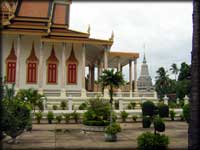 The silver pagoda in the grounds of the Royal
Palace. The silver pagoda in the grounds of the Royal
Palace.Inside the floor has over five tonnes of silver in patterned tiles, as well as various buddha images in obscenely precious stones and metals. Over 60% of what was there was destroyed by the Khmer Rouge, but what remains is spectacular. It is surprising that anything remains. |
 Enclosing the Silver Pagoda compound is a mural displaying
scenes from the Ramayana (a Sanskrit poem), however, much damaged by rising damp and neglect over
twenty years on the lower half. Since this was painted in about 1900, it is not so old compared to the
temples of Angkor, say, but it is four years older than the equivalent in the Bangkok Royal Palace. Enclosing the Silver Pagoda compound is a mural displaying
scenes from the Ramayana (a Sanskrit poem), however, much damaged by rising damp and neglect over
twenty years on the lower half. Since this was painted in about 1900, it is not so old compared to the
temples of Angkor, say, but it is four years older than the equivalent in the Bangkok Royal Palace. |
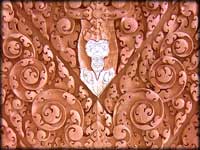 Wood carving skills have been revived
and many institutions and shops now sport the results. Here, a carving is in progress using a template on
paper glued to the flat surface and the wood chiselled out by hand. This takes weeks. Wood carving skills have been revived
and many institutions and shops now sport the results. Here, a carving is in progress using a template on
paper glued to the flat surface and the wood chiselled out by hand. This takes weeks.The patterns here mirror the stone carvings at Angkor and show it true origins - a copying of previous work done in wood. |
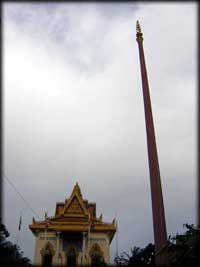 The spire(s) at the local pagoda are finally finished. The spire(s) at the local pagoda are finally finished.Go to top of page |
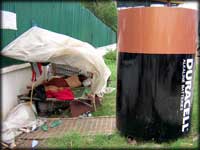 And just in case you thought most people
live in the standard of a Royal Palace, here is the family whose house is mostly plastic, living behind
a duracell battery. They have a low table, on which you can see two people sleeping, and a mat outside.
The plastic may keep most of the rain off, but probably not all of it. The river is perhaps fifty metres
away, so that takes care of ablutions. And just in case you thought most people
live in the standard of a Royal Palace, here is the family whose house is mostly plastic, living behind
a duracell battery. They have a low table, on which you can see two people sleeping, and a mat outside.
The plastic may keep most of the rain off, but probably not all of it. The river is perhaps fifty metres
away, so that takes care of ablutions. Clearly this accommodation is temporary, but for how long is the question. |
 They reckon that sleeping out in the car is not
always that comfortable. They reckon that sleeping out in the car is not
always that comfortable. Well, how about sleeping out on the motorcycle? Just not too much tossing and turning. This is a midday siesta for a motodop driver who makes his living taking people to their destinations by motorcycle. |
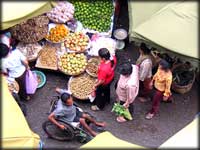 Wheelchairs. They are a common sight. Wheelchairs. They are a common sight. There is no social welfare system in Cambodia, so if you have a disability, particularly a severe one, there are no payments to help you. You are considered by the society to by less than a whole person, so finging employment is difficult. This leaves you the option of begging to make some money. This works to an extent, provided there are not too many beggars at the one time, since Cambodians are Buddhists and believe that it is good karma to give alms to the poor. Each person will only give a little, but it adds up over a day. But this means that the disabled must be out all day, either moving around the streets or markets or finding a spot to stand, sit or lie to beg from passers-by. This man has polio so that his legs are withered. He travels the market route looking for handouts from vendors and customers alike. |
 Plastic is not all that heavy, but a lot of plastic is very heavy.
Plastic is not all that heavy, but a lot of plastic is very heavy. The skill lies in tying it down. Go to top of page |
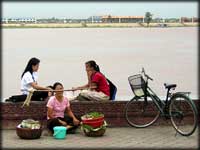 Recreation? Recreation?Go down to the riverside and sit and talk and maybe buy some snacks from the vendors carrying around their wares on shoulderboards with some of them cooking food freshly on the spot. Watch the river and life pass you by. |
 The Phnom Penh tee shirt factor. The Phnom Penh tee shirt factor.What is popular? Angkor Wat. The Khmer script. Landmine warnings. Monks. Cambodia. Beer. UNTAC. Local cafes. |
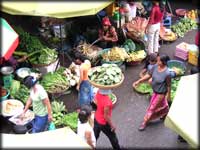 Outdoor markets are good up to a point. Outdoor markets are good up to a point.Usually the point where it starts to rain, then it is wet, gets muddy and becomes impossible. |
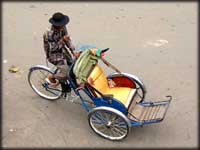 The lone cyclo. The lone cyclo.Waiting for his fare. It won't be us this time.... |
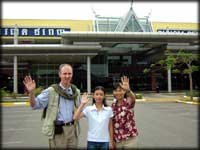 Bye Cambodia! Bye Cambodia!This is the international airport at Phnom Penh. The last portal to pass through for this journey. Thanks for coming along. It's been fun. |
Want to send Frecko a message? Click here: frecko@large